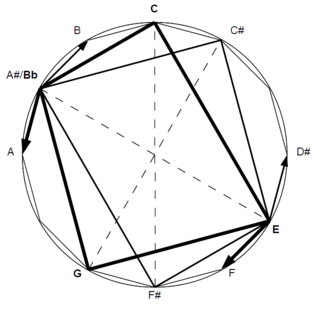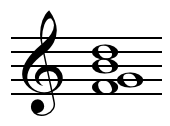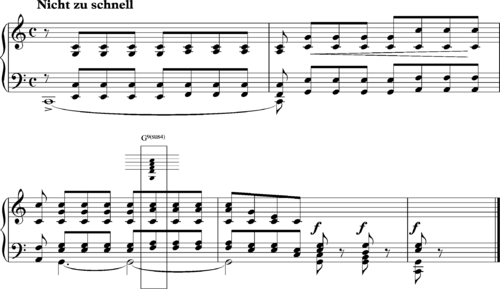In music theory, a leading-tone is a note or pitch which resolves or "leads" to a note one semitone higher or lower, being a lower and upper leading-tone, respectively. Typically, the leading tone refers to the seventh scale degree of a major scale, a major seventh above the tonic. In the movable do solfège system, the leading-tone is sung as ti.
A seventh chord is a chord consisting of a triad plus a note forming an interval of a seventh above the chord's root. When not otherwise specified, a "seventh chord" usually means a dominant seventh chord: a major triad together with a minor seventh. However, a variety of sevenths may be added to a variety of triads, resulting in many different types of seventh chords.

In music, a chord is a group of three or more notes played simultaneously, typically consisting of a root note, a third, and a fifth. Chords are the building blocks of harmony and form the harmonic foundation of a piece of music. They can be major, minor, diminished, augmented, or extended, depending on the intervals between the notes and their arrangement. Chords provide the harmonic support and coloration that accompany melodies and contribute to the overall sound and mood of a musical composition. For many practical and theoretical purposes, arpeggios and other types of broken chords may also be considered as chords in the right musical context.
In music theory, an augmented sixth chord contains the interval of an augmented sixth, usually above its bass tone. This chord has its origins in the Renaissance, was further developed in the Baroque, and became a distinctive part of the musical style of the Classical and Romantic periods.
The term sixth chord refers to two different kinds of chord, the first in classical music and the second in modern popular music.

In music or music theory, a thirteenth is the note thirteen scale degrees from the root of a chord and also the interval between the root and the thirteenth. The thirteenth is most commonly major or minor.

In music theory, an eleventh chord is a chord that contains the tertian extension of the eleventh. Typically found in jazz, an eleventh chord also usually includes the seventh and ninth, and elements of the basic triad structure. Variants include the dominant eleventh (C11, C–E–G–B♭–D–F), minor eleventh (Cm11, C–E♭–G–B♭–D–F), and major eleventh chord (Cmaj11, C–E–G–B–D–F). Using an augmented eleventh produces the dominant sharp eleventh (C9♯11, C–E–G–B♭–D–F♯) and major sharp eleventh (Cmaj9♯11, C–E–G–B–D–F♯) chords.
In music theory, a ninth chord is a chord that encompasses the interval of a ninth when arranged in close position with the root in the bass.
The ninth chord and its inversions exist today, or at least they can exist. The pupil will easily find examples in the literature [such as Schoenberg's Verklärte Nacht and Strauss's opera Salome]. It is not necessary to set up special laws for its treatment. If one wants to be careful, one will be able to use the laws that pertain to the seventh chords: that is, dissonances resolve by step downward, the root leaps a fourth upward.
In music theory, a dominant seventh chord, or major minor seventh chord, is a seventh chord, composed of a root, major third, perfect fifth, and minor seventh. Thus it is a major triad together with a minor seventh, denoted by the letter name of the chord root and a superscript "7". In most cases, dominant seventh chord are built on the fifth degree of the major scale. An example is the dominant seventh chord built on G, written as G7, having pitches G–B–D–F:
In Classical music theory, a Neapolitan chord is a major chord built on the lowered (flatted) second (supertonic) scale degree. In Schenkerian analysis, it is known as a Phrygian II, since in minor scales the chord is built on the notes of the corresponding Phrygian mode.
The diminished seventh chord is a four-note chord composed of a root note, together with a minor third, a diminished fifth, and a diminished seventh above the root:. For example, the diminished seventh chord built on B, commonly written as Bo7, has pitches B-D-F-A♭:

In music theory, chord substitution is the technique of using a chord in place of another in a progression of chords, or a chord progression. Much of the European classical repertoire and the vast majority of blues, jazz and rock music songs are based on chord progressions. "A chord substitution occurs when a chord is replaced by another that is made to function like the original. Usually substituted chords possess two pitches in common with the triad that they are replacing."

The tritone substitution is a common chord substitution found in both jazz and classical music. Where jazz is concerned, it was the precursor to more complex substitution patterns like Coltrane changes. Tritone substitutions are sometimes used in improvisation—often to create tension during a solo. Though examples of the tritone substitution, known in the classical world as an augmented sixth chord, can be found extensively in classical music since the Renaissance period, they were not heard until much later in jazz by musicians such as Dizzy Gillespie and Charlie Parker in the 1940s, as well as Duke Ellington, Art Tatum, Coleman Hawkins, Roy Eldridge and Benny Goodman.

In music, especially modern popular music, a slash chord or slashed chord, also compound chord, is a chord whose bass note or inversion is indicated by the addition of a slash and the letter of the bass note after the root note letter. It does not indicate "or". For example, a C major chord (C) in second inversion is written C/G or C/G bass, which reads "C slash G", "C over G" or "C over a G bass". Some chords may not otherwise be notated, such as A♭/A. Thus, a slash chord may also indicate the chord form or shape and an additional bass note.
In music theory, the half-diminished seventh chord is a seventh chord composed of a root note, together with a minor third, a diminished fifth, and a minor seventh. For example, the half-diminished seventh chord built on B, commonly written as Bm7(♭5), or Bø7, has pitches B-D-F-A:

In jazz, a turnaround is a passage at the end of a section which leads to the next section. This next section is most often the repetition of the previous section or the entire piece or song.
In music theory, an inversion is a rearrangement of the top-to-bottom elements in an interval, a chord, a melody, or a group of contrapuntal lines of music. In each of these cases, "inversion" has a distinct but related meaning. The concept of inversion also plays an important role in musical set theory.
In music, harmonization is the chordal accompaniment to a line or melody: "Using chords and melodies together, making harmony by stacking scale tones as triads".

In music, the seventh factor of a chord is the note or pitch seven scale degrees above the root or tonal center. When the seventh is the bass note, or lowest note, of the expressed chord, the chord is in third inversion.
Musicians use various kinds of chord names and symbols in different Contexts Chord notation is a system used to represent chords in written music or chord charts. It typically consists of one or more letters representing the root note of the chord, along with additional symbols or letters indicating the chord quality, extensions, and alterations. For example, the chord notation "CMA J7" represents a C major seventh chord, while "Dm7b5" represents a D minor seventh flat five chord. Chord notation allows musicians to quickly understand and play various chords in a piece of music without having to read the full musical score. to represent musical chords. In most genres of popular music, including jazz, pop, and rock, a chord name and its corresponding symbol typically indicate one or more of the following:
- the root note,
- the chord quality,
- whether the chord is a triad, seventh chord, or an extended chord,
- any altered notes,
- any added tones, and
- the bass note if it is not the root.














